Work boots don’t have much glamour associated with them. They probably need an image upgrade. But if you have a job to do, you need footwear that can work as hard as you do. You might need these Rocky Rebounds®.
by Leon Pantenburg
Disclaimer: Rocky provided the product for this review. I don’t work for the company and I was not paid to review the boots. This post is strictly my opinion, and nobody had any input in it. All I ever promise is a fair shake.
I grew up in the trades and have a tremendous respect for craftsmen and craftswomen. My dad was a carpenter and farmer, and I was operating a Skilsaw™, helping build barns, sheds and hog houses, working concrete, driving a tractor and doing assorted farm jobs from the time I was about 14. I was a typical Iowa farm kid. No matter how hard, hot and unpleasant the job was (I’m recalling cleaning dairy barns in the spring here!) you did it with pride.
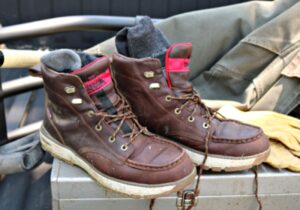
Your boots are an important part of your work tools. These Rocky Rebounds may be what you need.
Many of my buddies graduated from high school and went into the trades. These guys were smart and hard-working, but college didn’t interest them. They went through apprenticeships or community college courses, and ended up with solid job skills, no crippling college debt and a head start to success. I became a wordsmith, but my first job after college graduation was in construction. The first day on the job, I needed a hard hat, 25-foot steel tape, 22-ounce framing hammer and sturdy work boots.
Boots were a big deal. I was on my feet all day, climbing ladders and scaffolds, frequently carrying heavy loads and working on roofs and siding. During my working man “Gap Year” during college, I worked at a transmission factory, and stood all day on concrete floors. Quality footwear was a must. The boots needed to provide ankle support and have solid, reliable soles that wouldn’t slip in oil or solvent. The boots/shoes had to be tough, but still comfortable for long hours on the job.
We looked for boots like these Rocky Rebounds®.
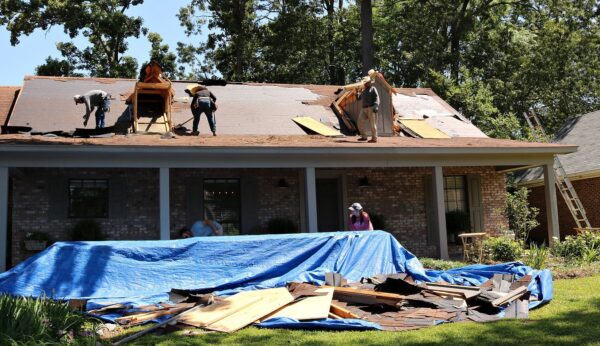
Hard-working people need solid, durable footwear.
Rocky Rebound Specs:
- 6 Inches in height
- ASTM F2892 electrical hazard standard
- Rocky Rebound EVA Midsole for Shock Absorption
- Waterproof Full Grain Leather
- Oil & Slip Resisting Rubber Outsole
- Rocky Rebound Footbed
- 1 Year Vapor Pass Breathable Recycled Membrane Waterproofing
- Weight – 1-1/2 pounds
- Heel height – 1-1/2 inches
- Made in Vietnam
The Rebounds are not my first pair of Rocky boots. Working in Washington D.C. I was often out in inclement weather wearing dress clothes. A wool overcoat, wool fedora and waterproof, insulated Rockys worked for me. The black Rockys could be polished. They looked good and felt really good when snow and slush were on the ground!
Here’s how the Rebounds have worked out so far.
Fit: I wear size 11 wide in all my work/hiking/trekking boots. They feel a little roomy when first put on in the morning. But everybody’s feet swell some if you’re doing a lot of walking and standing. IMHO, most people buy shoes that are too small, especially when it comes to walking shoes. By the end of the day, they wonder why their feet hurt.
The Rebounds fit me well, and they appear to fit true to size.
Height: A six-inch high boot is a good compromise. A low cut shoe is cooler, but outdoors, you’ll kick debris down the back. A ten-inch boot offers more protection, but they are hotter, and more of a pain to take on and off. For day-in, day-out wear you can’t beat a six-inch high boot.
Break-in time: A solid, full-grain leather boot is going to take some breaking in. The first day I got them, I wore the Rebounds for about 45 minutes and some two miles around an asphalt track. They were comfortable right off the bat, with no rubbing or chaffing. After about 20 cumulative miles of hiking, they are broken in, and I wouldn’t hesitate to wear them on a long hike. (Here is how to break in your boots.)
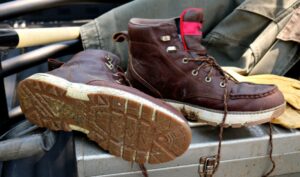
The tread and soles are practical and grip well.
Sole: Oil and slip-resisting. I tried this out on a wet marina deck and on a just-rained wooden step. The boots were not slippery, and the sole material appears to work well. The sole is also self-cleaning, which is a bonus.
ASTM F2892 electrical hazard standard: I had no way of testing this. But it seems like a good idea for a work boot to have it.
According to ASTM F2892 (TyndaleUSA.com) “This specification covers minimum requirements for the performance of footwear to provide protection against a variety of workplace hazards other than the toe area that can potentially result in injury.”

1982: As a working photo-journalist, I often wore jeans and full-grain leather work boots on assignment.
Footwear is built with nail-free construction to help insulate you from the ground to slow down conduction, but is not intended to be primary protection against electric shock. Leather footwear must be dry. The specification, according to Tyndale, contains performance requirements to protect workers’ feet by providing the following protection:
- Conductive properties, which reduce hazards that may result from static electricity buildup; and reduce the possibility of ignition of explosives and volatile chemicals.
- Electric hazard protection, to protect wearers when accidental contact is made by stepping on a live electric wire.
- Static dissipative properties to reduce hazards due to excessively low footwear electrical resistance that may result where SD footwear is required.
- Puncture resistance footwear devices.
Any job site will have extension cords and electrical stuff on it, and there is a reason accidents are called accidents.
Waterproof full grain leather: This is the material of choice for footwear that is going to be used hard. My dad, a carpenter, would wear out his shoes on the outer sides first when he was doing a lot of roofs. Roofers, in particular, are hard on their boot uppers. Their footwear material of choice is usually full grain leather.
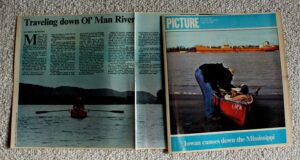
My leather work boots served me well on my 1980 Source-to-Sea canoe voyage of the Mississippi River.
Weight: One and one/half pounds. These are not lightweights, but a sturdy boot with these quality materials is not going to be. A lightweight shoe or boot is an abomination if your feet start hurting halfway through the work day.
Moisture barrier: New one-year guaranteed Rocky Recycled Vapor Pass Waterproof Technology. I can’t tell yet if these work as advertised yet, since it has been so hot and humid here in Mississippi. I wore the Rebounds on a recent foraging hike in a swamp and sweat through all my clothes and hat. I did wade a creek, and the boots didn’t ship any water I could tell. Sometimes, it’s just hot, and nothing you wear will make much difference.
Then there’s this:
I am not writing advertising copy, and you didn’t read this far to only learn about the good aspects of the product. I don’t like moisture barriers in this kind of boot. Everybody’s feet sweat. The Vapor Pass offers some breathability but your feet will still sweat in high temperatures and direct sunlight. Your socks will get soggy, your feet will soften up, and blisters may follow.
As far as I can tell, there isn’t a waterproof barrier that can dissipate moisture as fast as it is created inside the footwear. Of course, full-grain leather is going to be hot when it is hot outside. That said, if you’re going to be in environments that could get muddy or wet, moisture barriers might be a good idea. Base all your footwear choices on the anticipated wear.
Ticky and Nit Picky: I know there are many excellent products that come from overseas. These Rockys are an excellent product and they are made in Vietnam. I wish they were made here in the United States. I buy American whenever possible.
Do you need a pair of Rebounds?
IMHO everybody needs a pair of sturdy, solid hiking/work boots. You can toss them in the trunk of your car, store them with your bug out bag and wear the boots to the store, the mall or to mow the lawn. In an emergency, you can wear them to get home or get away. Slip them on to go anywhere – you’ll find yourself wearing them a lot more than imagined.
I REALLY like these Rebounds. If you don’t have a pair of sturdy work boots, consider buying Rebounds . You won’t be sorry.
I love this song – thank you working people – you deserve good, solid boots!
There are a lot of factors that determine how comfortable your hiking footwear will be. Consider these things when you are shopping:
- Shoes or boots for hiking?
- Waterproof or not?
- What are the best socks for the conditions?
- How do you avoid getting sore feet?
- Will the shoes or boots keep your feet warm?
Please click here to check out and subscribe to the SurvivalCommonSense.com YouTube channel – thanks!

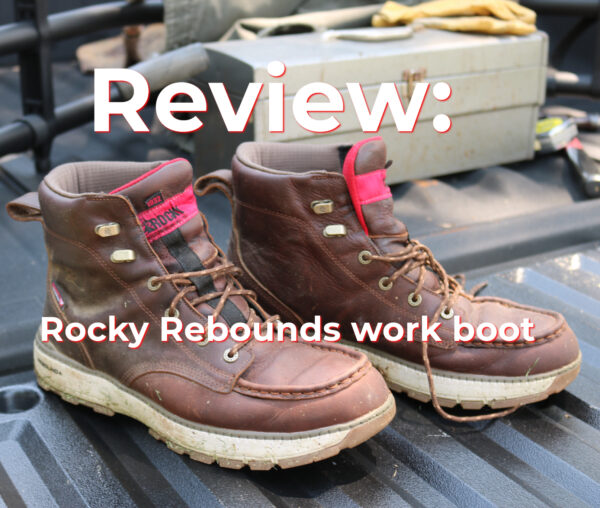
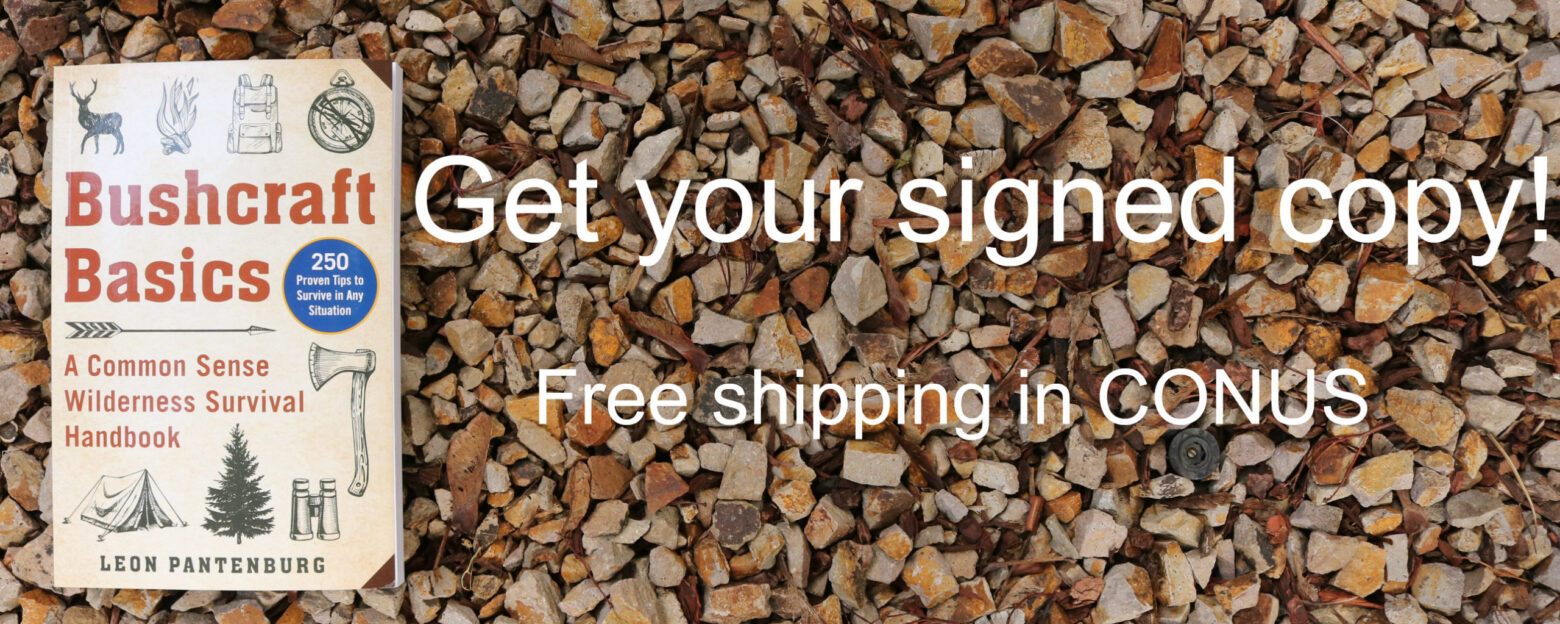
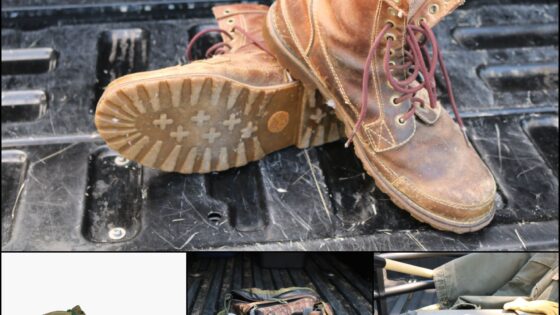
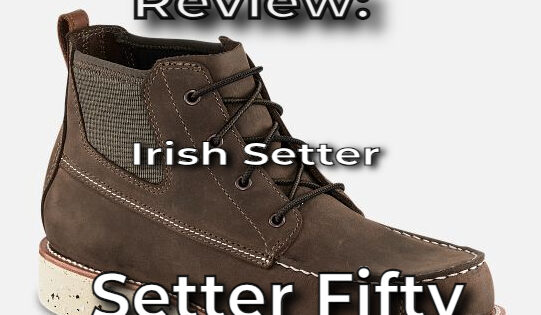

Leave a Reply